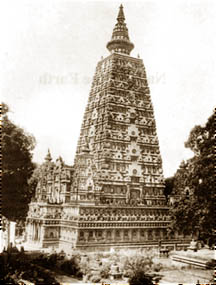|
dailynews |
|
|
|
|
|
OTHER LINKS |

|

|

|
|
Centre of Buddhist faith: Bodh Gaya
As you climb the broad marble steps and enter the precincts of Bodh Gaya Temple, you forget the squalor outside its boundaries... Beggars, most of them disabled, sales shacks and vendors' pitches built all over, vehicles parked haphazardly, rickshaws plying past ... Within the boundaries of the temple, you become a calmer, quieter being .... And you inevitably begin to chant the Homage to the Buddha .... the sonorous chant rising up and falling ..... Before you enter the precincts proper at your left you see a plaque which reads "welcome to the land of enlightenment" underneath it marks - A world heritage site. This is Bodh Gaya, majestic Maha Bodhi Temple built over the very spot where the Buddha attained enlightenment. Built following the classical Indian temple architecture, the temple has one large inward sloping spire 52 metres high and four smaller ones rising from a rectangular base; inside of which is the sanctum. The temple is built entirely of brick except for the door frames. The paving on the floor, and the four pillars at the entrance are made of blue-black granite. The temple which was badly ruined by the 19th century was restored by the British archaeologists J.D. Beglar and Alexander Cunningham. At the back of the temple, in a stone enclosure is the Bodhi Tree, called 'pipal' in Hindi. it sheltered the Buddha during his endeavour of enlightenment. Though, the present tree is not the original tree that sheltered the Buddha. Legend says that king Asoka's wife cut down the Bodhi Tree out of jealousy but that it miraculously sprouted again. King Sasanka, the anti-Buddhist king destroyed the Tree in about 600 CE and it must have died off and replanted at least on several other occasions. Before the tree died again in 1871, Alexander Cunningham took a seed from it, and planted it in its place in 1880. Leaving the Bodhi tree and going to the north side of the temple you will come to Ratanacakmana Chaitya, marking the place where the Buddha mindfully walked up and down for seven days to stretch his legs during his third week at Bodh Gaya. Directly outside the north gate within the temple railing, you find a large foundation of a rectangular building. Here, you can see Tibetan monks doing prostrations. This is the remains of the Animisa Chaitya, Unblinking Shrine which marks the place where the Buddha sat gazing without blinking at the Bodhi Tree out of gratitude. Just before his Great passing away, the Buddha encouraged all his disciples to visit at least once the places where the most important events in his life occurred. Lumbini, Bodh Gaya, Isipathana and Kusinara. 'Ananda, there are four places the sight of which will arouse strong emotion in those with faith'. Which four? 'Here the Tathagata was born', this is the first place. 'Here the Tathagata attained Enlightenment', this is the second place. 'Here the Tathagata set in motion the Wheel of the Dhamma', this is the third place. 'Here the Tathagata attained final Nirvana without remainder', this is the fourth place. The monk or nun, layman or laywoman, who has faith should visit these places. And anyone who dies while making a pilgrimage to these places with a devout heart will, at the breaking up of the body, be reborn in heaven.' - Digha Nikaya This shows that although the Buddha had high regard for reason, at the same time, He recognized the importance of emotion in all human efforts including the quest for enlightenment. For a devout person, going to a place made sacred by the Buddha's presence or even the process of getting there can have a transformational effect..... Bodh Gaya, this large village situated in the southern part of the Indian state of Bihar was known as Uruwela in the time of the Buddha. With the Enlightenment of the Buddha the location came to be known as Bodh Gaya, and the focus of attention for millions of pilgrims for over two millennia and the most important place of Buddhist worship. Bodhimanda, Vajirasana and Mahabodhi are the other names for Bodh Gaya. Beside the village Bodh Gaya flows the river which is known as Neranjana in the Buddhist Scriptures. It is a wide river, as probably three times as wide as River Kelani, but shallow even in rainy seasons. Known as River Iilanjan today, about a kilometre past Bodh Gaya it flows into Mohana after which it gets the name Phalgu. River Phalgu is considered sacred to the Hindus. Legend says that the Buddha bathed in this river before and after His Enlightenment.
|

 BODH GAYA: Early winter sky is still pink with the rays of the
morning sun, which is still much below the cone-shaped domes of Bodh
Gaya. A familiar fragrance of Rukattana flowers wafts in the air.
BODH GAYA: Early winter sky is still pink with the rays of the
morning sun, which is still much below the cone-shaped domes of Bodh
Gaya. A familiar fragrance of Rukattana flowers wafts in the air. 







